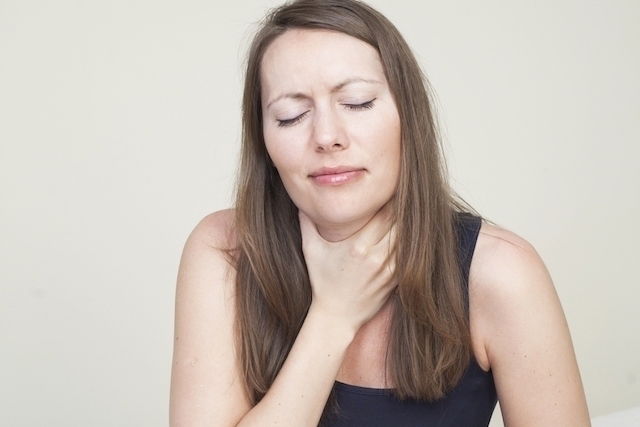Blisters in the throat can occur for a variety of reasons, such as infections, certain treatments or illnesses, which can spread to the tongue and esophagus and become red and swollen. These blisters can interfere with swallowing and speaking.
Since there are several causes for this symptom, you are advised to consult a general practitioner or an ENT specialist for a more thorough assessment. Once the underlying cause is identified, in order to initiate appropriate treatment.
Treatment generally consists of using of analgesics, anti-inflammatories, syrups or antibiotics.

What causes blisters in the throat?
The main causes of blisters in the throat are:
1. Cancer treatments
Both radiation therapy and chemotherapy are treatments that can lead to reduced immunity, which can cause several side effects, like formation of blisters in the throat.
What to do: To relieve side effects related to cancer treatment, it is important to keep your mouth and throat well hydrated and to eat soft foods, such as watermelon, bananas and vegetables.
2. Infections
The growth of microorganisms in the mouth can lead to blisters in the throat. Microorganisms are naturally found in the mouth, however situations that can interfere with immunity or expose the mouth to many microorganisms can lead to an uncontrolled growth of microorganisms.
What to do: You should seek a doctor for assessment, so that the type of microorganism that caused the blisters in the throat can be identified and, thus, treatment can be started. Treatment may involve antifungals, antivirals or antibiotics. It is also to clean your mouth properly.
3. Oropharyngeal cancer
One of the symptoms of oropharyngeal cancer is the presence of blisters or sores in the throat that do not heal within 15 days. In addition, throat pain, irritation and the presence of red or white spots on the gums, tongue, lips or throat are indicative of oropharyngeal cancer.
What to do: It is important to see your doctor if you notice any symptoms of oropharyngeal cancer so that treatment can be started as quickly as possible. Treatment generally surgical removal of the tumor, followed by chemotherapy and radiation therapy sessions.
4. Aphthous stomatitis
Aphthous stomatitis, popularly known as mouth ulcers, are rounded, white wounds that can appear in the throat and cause discomfort when swallowing or speaking.
What to do: Treatment for cold sores in the throat is carried out according to the doctor's instructions, and is normally done with the use of ointments and stopping the consumption of acidic foods, as they can increase discomfort. Check-out ways to treat mouth ulcers.
5. Herpangina
Herpangina is a viral disease that occurs most frequently in babies and children between 3 and 10 years old. It is characterized by fever, sore throat and the presence of mouth ulcers and blisters.
What to do: Treatment for herpangina is directed by a pediatrician, who may prescribe medication to relieve symptoms of discomfort, such as acetaminophen or topical lidocaine.
6. Behçet's disease
Behçet's disease is a rare disease, that occurs most frequently in people between 20 and 30 years old. It is characterized by inflammation of different blood vessels, leading to frequent diarrhea, bloody stools and wounds in the genital region and mouth.
What to do: Behçet's disease has no cure, and the use of medications, like anti-inflammatories and corticosteroids, is generally prescribe to relieve symptoms.
Other causes
In addition to these causes, there are others that can cause the appearance of bubbles in the esophagus and vocal cords, which can sometimes spread to the throat, such as gastroesophageal reflux, cold sores, HIV, HPV, use of some medications, excessive vomiting or alcohol abuse.
Also recommended: Sore Throat: Top 7 Causes (& What to Do) tuasaude.com/en/sore-throat
Possible symptoms
Blisters appear in the throat may emerge on their own, but they can also appear with other symptoms, such as difficulty swallowing, white spots on the throat, fever, pain in the mouth and throat, lumps in the neck, bad breath, difficulty moving the jaw, chest pain and heartburn.
Treatment options
The treatment of blisters in the throat depends on their underlying cause. It is very important to see a doctor for assessment and diagnosis. Blisters caused by an infection, for example, may be treated with antibiotics or antifungals.
To relieve pain and discomfort, you can take painkillers, such as acetaminophen, for example, or anti-inflammatories such as ibuprofen. In addition, you can use an antiseptic, healing and analgesic syrup to gargle 3 times a day, to relieve discomfort, in addition to maintaining good mouth hygiene.
Also recommended: Get Rid of a Sore Throat Fast: Home Remedies & Medication tuasaude.com/en/how-to-get-rid-of-a-sore-throatIt is also important to avoid spicy, hot or acidic foods, as these can further irritate the blisters. You should drink plenty of water, preferably cold, and eat cold foods, which can help to relieve pain and inflammation.
If the blisters are caused by GERD, the doctor may prescribe antacids or acid production inhibitors to prevent burning in the throat. Learn more about the GERD medications your doctor may prescribe to help manage symptoms.
